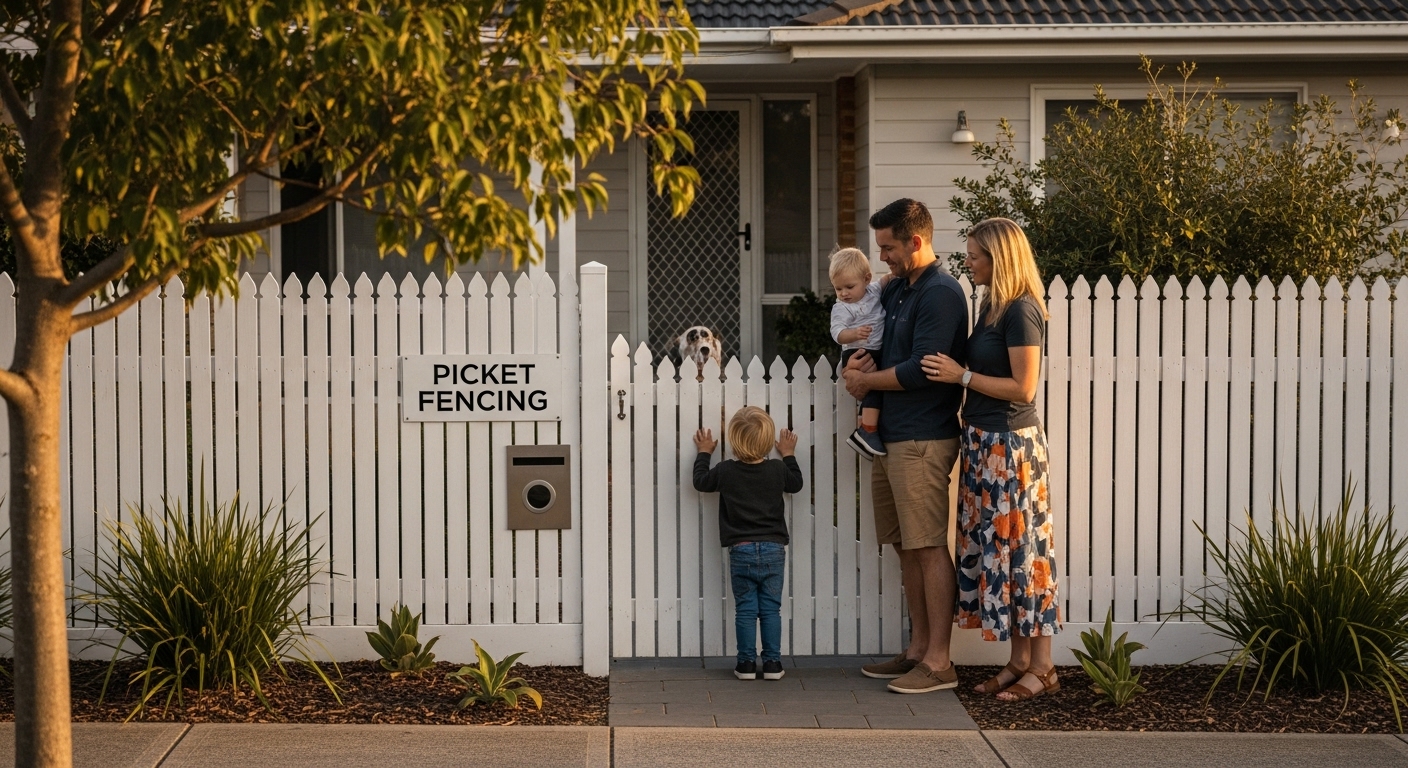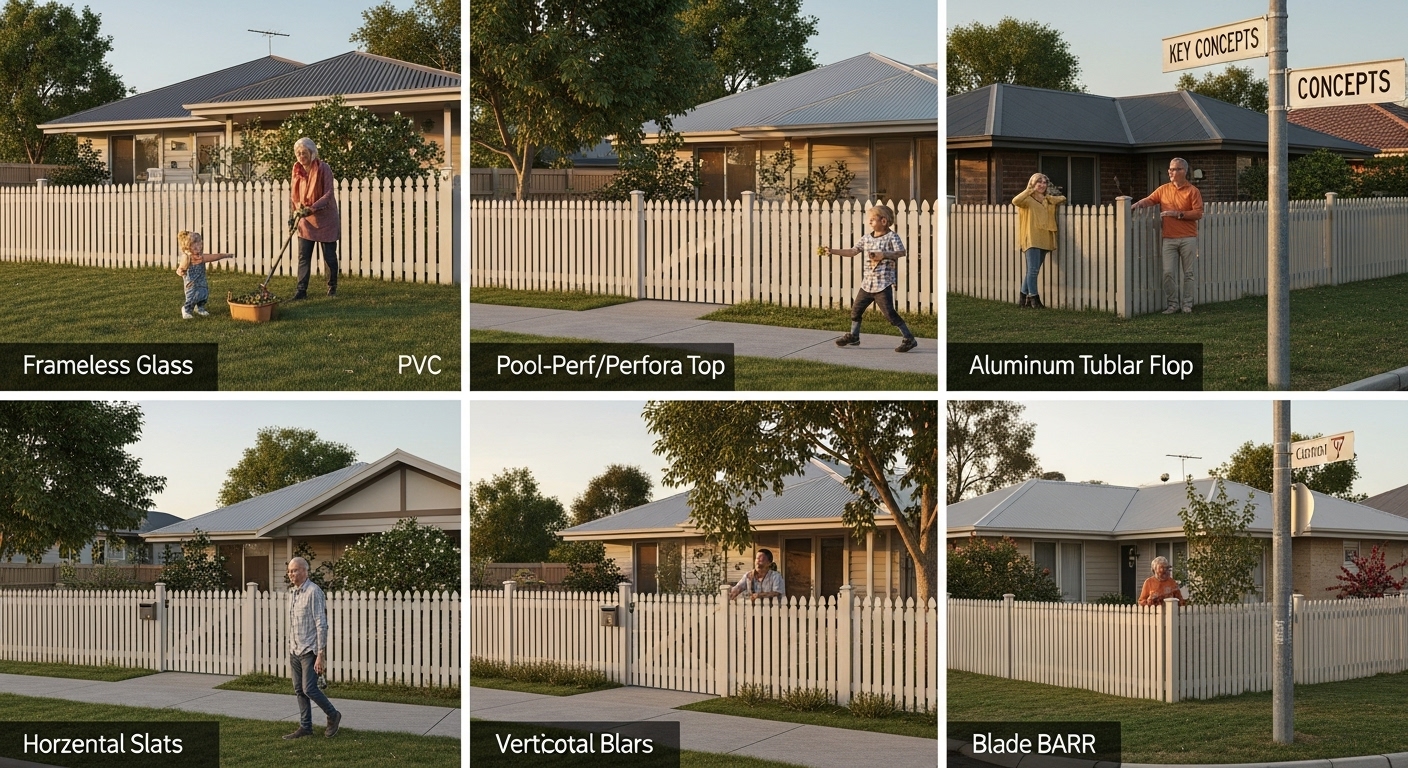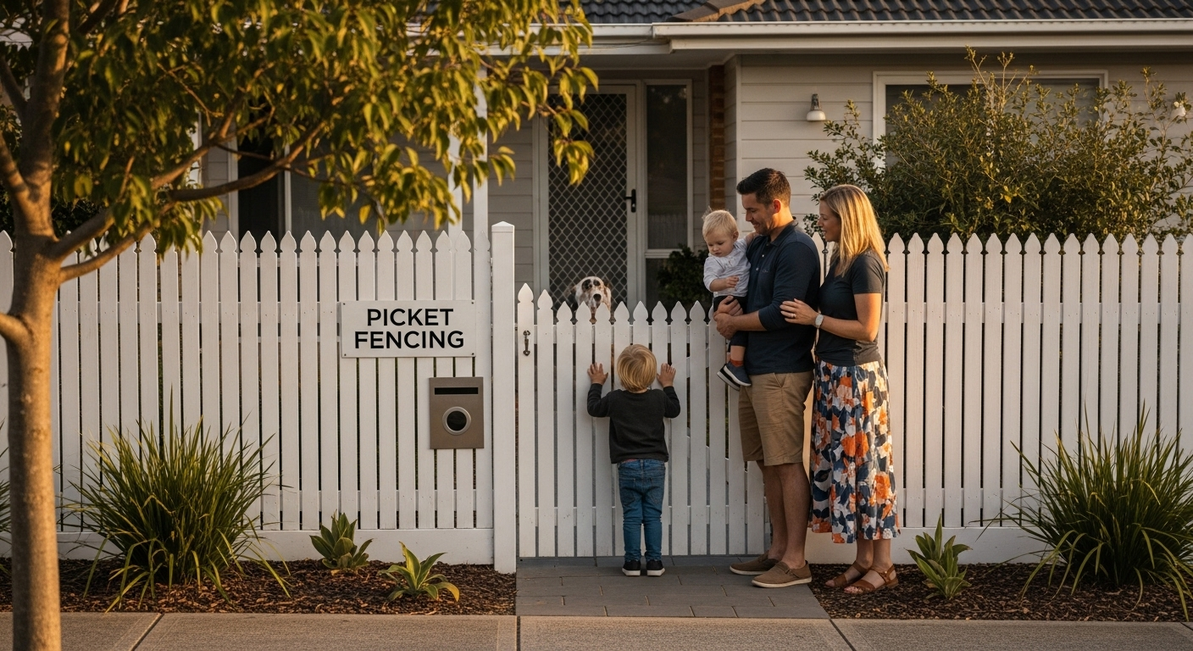Understanding Picket Fencing: Key Concepts and Importance
Understanding Picket Fencing: Key Concepts and Importance

Picket fencing has lined Australian streets for generations and its charm never seems to fade. There is something instantly recognisable about those evenly spaced slats, especially considering the classic designs often stand at just 900 to 1200mm high and may require at least 20 percent transparency for council compliance. Most would assume they are just quaint old barriers for front yards and gardens. Yet their true value goes far deeper than looks or nostalgia. These fences quietly protect homes, mark history, and help keep kids and pets safe, all while fitting strict laws most people never notice.
Table of Contents
Quick Summary
| Takeaway | Explanation |
| Picket fencing combines tradition and functionality | It serves as an aesthetic boundary while preserving architectural heritage in Australian homes. |
| Materials influence performance and appearance | Options like timber, aluminium, and vinyl each provide unique benefits for durability and maintenance. |
| Safety and security are primary benefits | Picket fences prevent unauthorised access and improve property security by defining clear boundaries. |
| Regulatory compliance is essential for design | Local guidelines dictate height, material, and visual transparency to maintain safety and uniformity. |
| Picket fencing enhances outdoor spaces | They play crucial roles in landscape management, making them essential for residential and commercial environments. |
What is Picket Fencing and Its Characteristics?
Picket fencing represents a classic architectural element that has adorned Australian residential landscapes for generations. These distinctive fences feature evenly spaced vertical timber or metal pickets attached to horizontal rails, creating a visually appealing boundary that balances aesthetics with functionality.
Historical Design and Cultural Significance
Picket fences have deep roots in Australian architectural heritage, particularly reflecting design traditions from Victorian and Federation era homes. Local heritage guidelines reveal that traditional picket fences typically range between 900 and 1200mm in height, with picket shapes varying according to architectural periods.
Historically, picket designs demonstrated remarkable diversity:
-
Victorian era pickets often featured shaped tops like pointed, half round, or acorn designs
-
Federation period fences frequently incorporated square tops with chamfered edges
-
Some designs integrated brick piers and low brick panels alongside timber pickets
Construction and Material Considerations
Modern picket fencing offers multiple material options beyond traditional timber, including aluminium, vinyl, and composite materials. Each material presents unique advantages:
![]()
-
Timber: Classic aesthetic, natural warmth, easily customisable
-
Aluminium: Low maintenance, rust resistant, modern appearance
-
Vinyl: Durable, minimal upkeep, consistent colour
The fundamental construction remains consistent: vertical pickets are securely attached to horizontal rails, which are then fixed between sturdy posts. This design provides both structural integrity and visual appeal, making picket fencing a versatile boundary solution for Australian homes.
To help you compare your options, here is a table summarising the main materials used for picket fencing, alongside their key features and maintenance requirements.
| Material | Appearance | Durability | Maintenance Needs | Key Advantages |
| Timber | Classic, natural warmth | Moderate | Needs regular painting or staining | Easily customisable, traditional look |
| Aluminium | Modern, sleek | High (rust resistant) | Very low | Lightweight, very low upkeep |
| Vinyl | Consistent colour, contemporary | High (weather resistant) | Minimal | No painting, durable over time |
| Composite | Timber-like, varied | Very high | Low | Eco-friendly, long life |
Whether surrounding a Federation cottage in Sydney or a modern suburban residence in Brisbane, picket fencing continues to represent more than just a property boundary. It symbolises a connection to architectural tradition while offering practical demarcation and aesthetic charm.
The Importance of Picket Fencing in Outdoor Spaces
Picket fencing plays a crucial role in defining, protecting, and enhancing outdoor spaces across Australian residential and commercial environments. Far more than a simple boundary marker, these versatile structures serve multiple critical functions that contribute to safety, aesthetics, and property management.
Safety and Boundary Definition
In outdoor environments, picket fencing provides essential safety mechanisms. Queensland educational guidelines emphasise the importance of appropriate fencing in preventing uncontrolled movement, particularly in spaces used by children. The strategic design of picket fences creates clear physical boundaries that:
-
Prevent unauthorised access
-
Protect vulnerable spaces like children’s play areas
-
Clearly demarcate property limits
-
Provide visual guidance for movement and interaction
Security and Crime Prevention
Beyond physical boundaries, picket fencing contributes significantly to property security. Crime prevention experts highlight how well-designed fencing can deter potential offenders by:
-
Increasing perceived effort for potential intrusions
-
Defining clear property perimeters
-
Encouraging improved neighbourhood surveillance
-
Creating a psychological barrier against unauthorised entry
Environmental Protection and Resilience
Picket fencing also serves critical environmental protection functions. National emergency management guidelines recommend using appropriate fencing materials to mitigate environmental risks. Strategically designed picket fences can:
-
Block wind and reduce debris movement
-
Shield properties from potential bushfire ember attacks
-
Control radiant heat transmission
-
Provide additional landscape protection
Ultimately, picket fencing represents a multifunctional solution that extends far beyond simple aesthetic appeal. It serves as a critical interface between personal space and broader environmental contexts, offering protection, definition, and style in equal measure.
How Picket Fencing Works: Design and Materials
Picket fencing represents a sophisticated yet straightforward architectural system that combines structural engineering principles with aesthetic design. Understanding its fundamental mechanics reveals a complex interplay between materials, construction techniques, and regulatory requirements.
Structural Configuration and Design Principles
Local council guidelines reveal that picket fencing follows a precise structural configuration. The fundamental design involves vertical pickets attached to horizontal rails, which are securely anchored between sturdy posts. This modular approach allows for remarkable flexibility in design and adaptation.
Key structural components include:
-
Vertical pickets (primary visual element)
-
Horizontal rails (structural support)
-
Fence posts (foundational anchoring)
-
Connective hardware (brackets, screws, fasteners)
Material Selection and Performance Characteristics
Material selection dramatically influences a picket fence’s performance, durability, and aesthetic appeal. Different materials offer unique advantages:
-
Timber: Traditional appearance, natural insulation, easily customisable
-
Aluminium: Corrosion resistant, lightweight, minimal maintenance
-
Vinyl: Weather durable, consistent colour, low ongoing maintenance
-
Composite: Blend of materials, enhanced longevity, reduced environmental impact
Regulatory Compliance and Design Constraints
NSW planning regulations impose specific requirements for residential picket fencing. Critical compliance considerations include:
-
Maximum height limitations (typically 1.2m for front boundaries)
-
Minimum visual permeability (at least 20% transparency)
-
Material restrictions in bushfire-prone areas
-
Specific gate operational guidelines
The intricate balance between design aesthetics, material performance, and regulatory compliance makes picket fencing a nuanced architectural element that extends far beyond simple boundary demarcation.
Key Concepts of Picket Fencing: Styles and Functions
Picket fencing represents a dynamic architectural element that transcends mere boundary demarcation, embodying historical design principles and contemporary functional requirements. Understanding its diverse styles and applications reveals a nuanced approach to residential and commercial landscaping.
Architectural Period Styles
Local heritage guidelines demonstrate how picket fencing styles reflect specific architectural periods, each with unique design characteristics. These historical variations showcase remarkable design sophistication:
-
Victorian Era: Ornate pickets with shaped tops like pointed, half-round, or acorn designs
-
Federation Period: Square-topped pickets with chamfered edges
-
Modern Contemporary: Minimalist designs with clean lines and uniform spacing
Functional Design Considerations
Beyond aesthetic appeal, picket fencing serves multiple practical purposes. Camden Council development regulations emphasise that effective picket fencing must balance visual transparency with functional requirements:
-
Provide clear property boundaries
-
Maintain visual connection with streetscape
-
Ensure minimum 20% visual permeability
-
Create secure yet welcoming property interfaces
Regulatory and Design Constraints
Picket fencing design is governed by intricate regulatory frameworks that ensure consistency, safety, and aesthetic harmony. Key design constraints include:
-
Maximum height limitations (typically 1.2 meters for front boundaries)
-
Material specifications for different environmental zones
-
Specific requirements for visual transparency
-
Considerations for bushfire-prone regions
These multifaceted design principles transform picket fencing from a simple boundary marker into a sophisticated architectural element that communicates both functional necessity and cultural heritage.
The following table provides an at-a-glance guide to the different historical and contemporary picket fence styles discussed in the article.
| Style | Era/Period | Typical Picket Features | Visual Characteristics |
| Victorian Era | Late 1800s | Shaped tops (pointed, half round, acorn) | Ornate, decorative |
| Federation Period | Early 1900s | Square tops with chamfered edges | Refined, symmetrical |
| Modern Contemporary | Present | Straight, clean lines, uniform spacing | Minimalist, streamlined |
| Mixed (Heritage re-creation) | Various | Brick piers/low panels with timber pickets | Combination of styles |
Real-World Applications of Picket Fencing in Australia
Picket fencing transcends theoretical design principles, emerging as a versatile solution across diverse Australian residential, commercial, and institutional environments. Its adaptability and functional characteristics make it a preferred choice for multiple landscaping and boundary management scenarios.
Residential Property Demarcation
NSW Planning regulations highlight specific parameters for residential picket fencing applications. Homeowners leverage picket fencing for:
-
Defining property boundaries with aesthetic elegance
-
Creating child-safe front yard environments
-
Enhancing street appeal and property value
-
Providing subtle security without aggressive visual barriers
Heritage and Historical Preservation
Picket fencing plays a crucial role in maintaining architectural authenticity, particularly in heritage-listed neighbourhoods. Local heritage guidelines demonstrate how these fences:
-
Preserve historical architectural character
-
Complement period-specific housing designs
-
Maintain streetscape visual continuity
-
Represent cultural architectural storytelling
Functional Landscape Management
Beyond aesthetic purposes, picket fencing serves critical functional landscape management roles across various Australian settings:
-
School and childcare centre boundary definition
-
Community garden perimeter management
-
Agricultural small-holding property segmentation
-
Urban community space demarcation
-
Sustainable landscape zoning
The enduring popularity of picket fencing stems from its remarkable ability to balance practical requirements with visual sophistication, making it an integral element of Australian architectural and landscape design.

Upgrade Your Picket Fence with Supplies That Last
Are you after a picket fence that does more than just mark out your property? This article has shown how picket fencing is about security, style, and protecting your outdoor space. But finding high-quality materials that balance both tradition and modern needs can be tough. Timber, aluminium, and vinyl all have their place—yet reliability and fast access often hold back the dream project.
Choose Fence Guru for trusted fencing supplies that keep your project compliant and looking great for years. With our huge in-stock range across Australia and trade-quality products used by the pros, your picket fence will deliver both visual appeal and lasting value. Whether you are reviving a heritage look or tackling a new build, you can get started on your fence today. Shop now at Fence Guru and experience the fast, easy way to complete your outdoor transformation.
Check out our Modern Designer Picket Fencing Options:
-
From ‘The Hamptons Collection’ - White Picket Fencing - PVC Double Rail Design - 1.2m high
-
Verti-Slat Designer Slat Picket Fencing in Off White, Monument & Satin Black - 1.2m high
-
Verti-Barr Designer Batten Picket Fencing in Pearl White or Satin Black - 1.2 and 1.8m high
Note: Option 2 & 3 are Home & Pool Fencing Compliant. Option 3 is great fro commercial applications.
Frequently Asked Questions
What is a picket fence?
A picket fence is a classic architectural element that consists of evenly spaced vertical timber or metal pickets attached to horizontal rails, creating a visually appealing boundary for residential properties.
What materials can be used for picket fencing?
Picket fencing can be constructed using various materials, including timber, aluminium, vinyl, and composite materials, each offering unique advantages such as aesthetics, durability, and maintenance requirements.
How does picket fencing enhance safety around outdoor spaces?
Picket fencing defines clear physical boundaries, preventing unauthorised access, protecting vulnerable areas like children’s play zones, and ensuring a safe environment in both residential and commercial settings.
What are the historical styles of picket fencing?
Historical styles of picket fencing include Victorian-era designs with ornate pickets, Federation period designs with square tops, and modern contemporary styles featuring minimalist designs with clean lines. Each style reflects specific architectural characteristics and heritage influences.
Recent Posts
-
The 3m Pool Fence Panel Secret: Faster Installs, Cleaner Design, No Waiting
When planning a pool area or long garden boundary, the equation is simple: longer panels mean fast …1st Oct 2025 -
A Complete Guide to PVC Post and Rail Fencing in Australia
PVC post and rail fencing might seem like just another choice for property boundaries in Australia, …23rd Sep 2025 -
Understanding Home Fencing Options for Your Property
Understanding Home Fencing Options for Your Property Home fencing is more than just a backyard divi …21st Sep 2025






